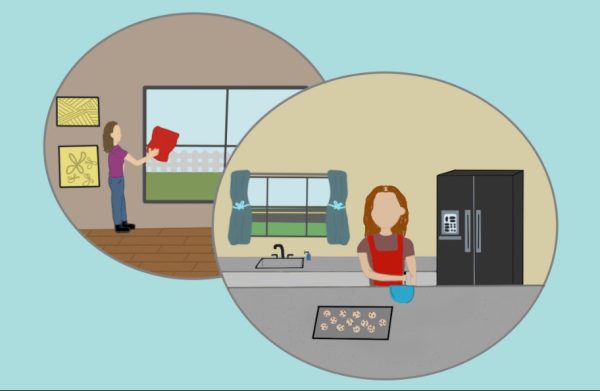Yes/No: Should BVH maintain block schedule next year?
Yes
By: Angelina Ruckman

Once distance learning began, Bonita Vista High (BVH) students were introduced to a different schedule to follow throughout the week. During pre-COVID with in-person learning, students were expected to go to each of their six or seven classes a day for around 50 minutes. This has been the expectation for years at not only BVH, but also many other schools in the Sweetwater Union High School District (SUHSD).
Now, after the transition to distance learning, depending on a student’s schedule, they have three to four classes a day due to block scheduling for an hour and a half every weekday except for Fridays. That hour and a half can be a mix of asynchronous and synchronous class. Arguably, this schedule is better than traditional scheduling. It will strongly benefit students, even during in-person learning.
So far throughout distance learning, students have adapted to the new ways of block scheduling, so a transition to block schedule for in-person learning wouldn’t be difficult for students to get used to. Having to go to all your classes each day, also known as traditional scheduling, can put a lot of stress on students, even the most hardworking ones. It requires students to have a single day to finish homework in many classes. With block scheduling there are fewer classes a day.
According to Brown University’s article, “Block Scheduling—Innovations with Time,” block schedule organizes the day into fewer, but longer, class periods to allow flexibility for instructional activities.
The expressed goal of block scheduling is to improve student academic performance by providing more time for students and teachers to work in a single class. Some other rewards of block scheduling is that it encourages the use of innovative teaching methods that address multiple learning styles and an improved atmosphere on campus.
Block scheduling has made a great impact on work performance and that is why block scheduling should be the new normal and continue into the next school year.
— Angelina Ruckman
According to an article conducted by the University of the People, “What is block scheduling and is it effective? Pros and cons,” a couple main pros of block scheduling are that teachers can take advantage of seeing fewer students per day. With fewer classes, collaborative learning can take place more easily. Secondly, teachers can build closer bonds with students and get to know their individual learning needs better. Lastly, less daily homework. Since students have fewer classes each day, it can translate into a lighter workload. When students have less daily homework, they have more time to pursue their interests, hone their skills and even reduce stress levels by having these extra activities.
According to Nesa Sasser, Ed.D., who wrote the article “Block Vs. Traditional Scheduling Student Perspective,” disadvantages of traditional scheduling include the fact that students have to prepare for at least six classes a day. If all six teachers give weighty homework assignments each day, it could cause havoc even for the best student, not to mention an average or less successful student.
Even when classes are an hour and a half long, most teachers during distance learning have asynchronous class time after a 30 to 50 minute synchronous class. For the students on campus currently, they go to class and learn in-person with their teacher for synchronous learning. Then they stay in the classroom for asynchronous and work on homework on their own with aid from teachers. Block schedule also includes a full day on Fridays. This means that once a week on Fridays, students go to all their classes for 40 minutes. This allows students to be able to catch up with their teacher and have better communication in case of missing work or questions they may have.
During traditional scheduling, teachers had to manage around 180 different students for six classes which can be stressful grading wise. Other than the performance of the students themselves, the classroom environment deeply depends on the attitude and teaching style of the teacher, which means that all classrooms are going to be different. This can be easier to manage with only a few classes a day. With asynchronous time available for students to do work, it also is a good opportunity teachers have to destress and grade paperwork that won’t interfere with the work they have the next day with a new set of students.
“If the teacher does not have effective classroom management, the amount of time that the student spends learning is decreased. Some courses do not lend themselves to shorter time periods, especially those courses that are project oriented, so teachers will have to adjust to new timing constraints,” Sasser said.
Allowing students to have a few classes a day during the pandemic has been a relief and benefit both students and teachers since many are unmotivated and have distractions at home. Block scheduling has made a great impact on work performance and that is why block scheduling should be the new normal and continue into the next school year.
No
By: Carina Muniz

‘I can’t continue this for another day.’
It’s as if the clock doesn’t tick by fast enough. Even though this—the block schedule that comes with state-wide testing—is only for a week, time couldn’t go by any slower. And even though the school day has almost come to an end, it feels as if the world has come to a complete stop.
With schools across the Sweetwater Union High School District (SUHSD) re-transitioning back to in-person learning, the question of whether students will continue to use a block schedule remains. Block schedule replaces the traditional schedule of six or seven 50 minute daily periods with longer class periods that meet fewer times each week. However, administrators and members of SUHSD have to consider what pursuing block schedule means for students.
During the portion of the 2019-2020 school year before the pandemic, Bonita Vista High (BVH) students utilized the traditional schedule, whereby students attend either one through six or one through seven classes a day. However, due to the COVID-19 pandemic, BVH has utilized a block schedule. According to a poll by the Crusader released on May 20, of 404 BVH students, 35.5 percent of students claimed that they would not prefer maintaining a block schedule once students return to in-person learning.
It’s no surprise that students need time to recharge after a class with breaks between passing periods. But some teachers and administrators have argued that an impersonal environment is created through an assembly-line, single-period daily regimen—similar to the continuous learning model of a traditional school schedule—which adversely affects student discipline.
Schedules that released thousands of students into hallways several times a day for three to five minutes seemed to cause a sort of “chaos,” according to the American Association of School Administrators (AASA)—The School Superintendents Association. School hallways are filled with students moving from one classroom to the next, stopping to communicate with friends or teachers.
Contrary to popular belief, the three to five minutes where this “chaos” ensues is actually a time for students to decompress from their previous class and prepare themselves for their next class. Understandably though, neither the AASA nor BVH can ensure that all students are using the time they have during the passing period to recharge themselves before their class.
According to a study by The University of People—The Education Revolution, A/B block schedules create a loss in continuity due to the constant change in a student’s daily schedule. Besides, learning the same subject for nearly two hours leaves students in a rut that creates an unproductive environment. Additionally, there is a greater risk of educational loss if a student is absent from class; they may miss more academic content in a block schedule compared to a traditional schedule.
With traditional scheduling, however, teachers have the ability to see their students everyday, which helps students retain and review information better. Daily student communication allows students to feel energized and focused on classroom activities.
It’s true that a standard one through six schedule requires some perfecting—allowing students to focus on their classes while minimizing distractions during the day. Traditional scheduling means that students have to prepare for up to seven classes a day, including the completion of daily homework assignments for each day. This could easily cause stress for even the most diligent student, however, teachers play a crucial role in how the classroom operates. Teachers must ensure that there is effective classroom management and that students can manage the workload. In the end, it is up to teachers and students to find a balance between work and learning.
Although attending six or seven periods a day isn’t an ideal learning model for everyone, it allows for students to differentiate the faces they see and subjects they learn every day. High school students are already lively people, many of whom enjoy change in their daily schedule, which is why traditional schedules are fulfilling and engaging for their learning environment. With six or seven classes a day, students can receive that change in their lives instead of staying in three or four classes for 90 minutes a day.
According to the AASA, currently, nearly 30 percent of the nation’s secondary schools use some form of block scheduling. The great thing about class scheduling is that there are so many available options for schools that allow students to meet all their credit requirements. As BVH transitions back to in-person learning, a traditional schedule should be re-established. Students should also familiarize themselves with other schedule options in order to advocate for themselves.
According to the Brown University article “Block Scheduling—Innovations with Time,” some examples of types of class scheduling are:
- Four by four block plan: The school day is divided into four 90-minute periods, including time added for lunch and passing periods. For the first semester, students attend their first four courses, where the second semester is for the next four classes.
- A/B plan: Each day is organized into three to four 90-minute periods but has a total of seven to eight classes meeting over two consecutive days. BVH has adopted and currently uses this schedule for distance learning since the COVID-19 pandemic began.
- Trimester plan: Here, students take two or three core courses each trimester for over 60 days, thus completing six to nine credits per year. Some variations include two long classes and one short class per day, two long and two short per day, or other patterns.
- 75-75-30 plan: Students take three classes each for two 75-day terms, followed by a 30-day intensive course or “enrichment program.” There are also variations that include placing the 30 days between the two 75-day terms, having three long classes and one short class, or changing the configuration to 75-15-75-15.
- Copernican plan: Students attend classes in large blocks of time over the course of 30, 45, 60 or 90 days depending on the format of the schedule selected. This schedule allows students to attend two, two-hour classes each morning. There is time in the afternoon for seminars and electives such as music, physical education and Advanced Placement classes. This plan includes several variations which can be referred to as macro scheduling.
By reverting back to the traditional class schedule, students may feel not only a sense of relief from the tiring two hour class period, but also from the sense of familiarity that sophomore, juniors and seniors all have experience with. No, block schedules nor traditional schedules aren’t the perfect and ideal models for class schedules. However, a reasonable solution to this debate is to allow students the opportunity to shape their own schedules. The COVID-19 pandemic has created new possibilities of learning and attending class that administrators and SUHSD members should consider pursuing, but block schedule shouldn’t be one of them.

I am a senior at Bonita Vista High and this year's Editor at Large for the Crusader. This is my fourth year on staff, last year being an Arts and Cultures...

Howdy! Currently, I am a senior at Bonita Vista High and finishing my fourth year on the Crusader staff. Now, I am co-Editor in Chief of the Crusader,...
















